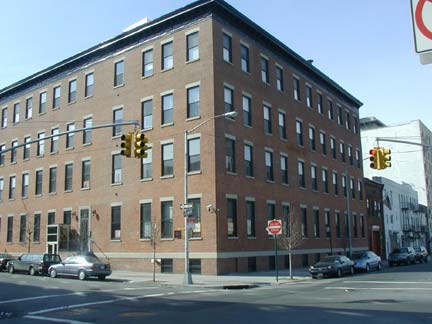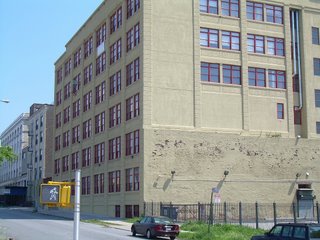The hearing is important both because of its the goal, long sought by Prospect Heights residents, and because it reminds us how landmarking is a political process, especially when historic preservation intersects with the Atlantic Yards project.

The hearing will be at the LPC’s offices in the Municipal Building, One Centre Street, in Manhattan, and approval at a later LPC meeting, which is expected, must be followed by approval by the City Planning Commission and City Council.
Public support
"Landmarking has received the support of hundreds of Prospect Heights residents," says the Prospect Heights Neighborhood Development Council. "It's also critical that community members attend the public hearing (and testify) in order to demonstrate the urgency of landmarking our neighborhood before another historic building is lost or irreparably altered." Those who can't attend can send comments to comments@lpc.nyc.gov.
Mayoral control and the Ward Bakery Of course, the LPC answers to the mayor, and thus there was no attempt to include historic buildings like the Ward Bakery, currently under demolition (photo from AY web cam), in the district map.
Of course, the LPC answers to the mayor, and thus there was no attempt to include historic buildings like the Ward Bakery, currently under demolition (photo from AY web cam), in the district map.
Nor was there an attempt to include former industrial buildings in the AY footprint like the Spalding Building (below) and the Atlantic Arts Building, which, unlike the bakery, are not eligible for the National Register of Historic Places but represent valuable investments in "embodied energy," the labor and resources already expended in construction and rehabilitation.
Michael D.D. White of Noticing New York recently commented on a New York Times editorial that argued that the LPC needed the "full backing of the mayor" to do its job. Rather, he argued, it would be more important for "the commissioners had greater independence from the mayor." He wrote of the Ward Bakery: "The building, which was in use until the mid-1990's, was being bought and sold by developers and probably would be under development now, soon to be adaptatively reused, had it not been for the advent of Bruce Ratner’s endeavors, blighting Prospect Heights and Fort Greene in pursuit of personal wealth."
He wrote of the Ward Bakery: "The building, which was in use until the mid-1990's, was being bought and sold by developers and probably would be under development now, soon to be adaptatively reused, had it not been for the advent of Bruce Ratner’s endeavors, blighting Prospect Heights and Fort Greene in pursuit of personal wealth."
Political difficulties
Given the imbalance of power between preservationists and developers, the former have to pick their spots, an issue which came up last Wednesday in a panel at the Municipal Art Society (MAS) on Recycling Industrial Buildings.
"If we tear down all remnants of our industrial past, how will future generations learn about it?" asked Mary Habstritt, president of the Society for Industrial Archaeology, making the case for preservation. She quoted architect Carl Elefante, who said, "The greenest building is one that's already built" and pointed to the concept of "embodied energy."
"I like to say that the greenest building is the one you don't send to a landfill," she said.
"I think that we need to be more careful with our buildings," commented Lisa Kersavage, MAS director of advocacy and policy. "Demolition is incredibly wasteful, and in New York City, 60% of our waste stream is demolition and construction debris, which is significantly higher than the rest of the country." She added that more jobs in the building trades are created via renovation than new construction.
In the audience, however, Stephanie Eisenberg, a developer and activist in Williamsburg, pointed to the failure to include more buildings in the landmarking of the former Domino sugar plant, in anticipation of the New Domino development. "How do you get the politics out of the landmarking process?" she asked. Panelists laughed nervously. "That's a difficult question," Kersavage responded. "I think we have to advocate, advocate, advocate. I think that, with the Domino site, MAS certainly was advocating for slightly more to be protected... We have to balance new development and preservation. I think, personally, in this case, it tipped a little bit more towards the new development, but I think there's still room to influence this project.
"That's a difficult question," Kersavage responded. "I think we have to advocate, advocate, advocate. I think that, with the Domino site, MAS certainly was advocating for slightly more to be protected... We have to balance new development and preservation. I think, personally, in this case, it tipped a little bit more towards the new development, but I think there's still room to influence this project.
With Atlantic Yards, MAS took a "mend it, don't end it" position, supporting adaptive reuse of the Ward Bakery and the LIRR stables, but not of renovated industrial buildings like the one building above (office space once destined for housing, at Carlton Avenue and Pacific Street), Spalding and Atlantic Arts.
MAS did comment that it is unacceptable for National Register-eligible buildings like Ward and LIRR to be demolished in Phase 1 for interim surface parking, given that Phase 2 could be redesigned. But MAS did not challenge the loss of renovated industrial buildings for the arena. (We'll know Forest City Ratner is really serious when they demolish Spalding, which, if Atlantic Yards fall through, could easily be filled with loft owners.)
Prospect Heights boundary issues 
The proposed district nudges right up to the AY footprint. For example 555-557 Carlton Avenue, as shown in the slide above, is on the southeast corner of Dean Street; on the northeast corner is part of the AY footprint. And just up the block, at the corner of Carlton Avenue and Pacific Street, is the yellow building pictured above.
Comments
Post a Comment